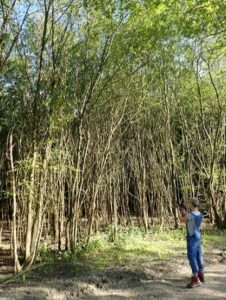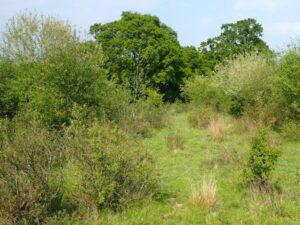Choosing the right tree species for your site will help it to thrive, look right, and provide a positive contribution to habitats. This section helps you to decide whether planting or natural regeneration would be better for your site, and – if you decide to plant – which species to select.
Planting or natural regeneration?
Allowing trees to naturally regenerate (or colonise) by encouraging natural succession is a great way to increase tree cover in the countryside, where it is appropriate and possible.
Where there is sufficient seed source in the soil and suitable site conditions, the benefits of natural regeneration and selection of trees best adapted to local circumstances include greater ecological complexity and diversity, increased resilience to climate change and disease, and avoiding the risk (with planting) of introducing new pests and diseases.
Natural regeneration also requires less management, less resources (no need for tree shelters, ties, containers or for growing trees and transporting them), and can be more cost effective than planting. For more, see Rewilding Britain’s Reforesting Britain’ report
If biodiversity is your key objective, you could consider natural regeneration rather than tree planting. Natural regeneration will be less appropriate for some urban schemes and productive woodland.
If your chosen site has poor seed stock sources (e.g. if it has been intensively farmed), direct seeding can be a good option to introduce seeds while encouraging natural establishment. Read more in the Creating new broadleaved woodland by direct seeding guide.
In reality, many schemes seeking naturalistic outcomes for biodiversity may include a mix of natural regeneration and some planting.
Left: Willow regenerating freely on the Knepp estate in a former arable field taken out of production around 15 years ago. Photo © Rob Wolton
Right: Regenerating area of the Knepp estate southern block where large herbivores are allowed to graze. Photo © Rob Wolton
Selecting tree and shrub species for planting
Select species that are appropriate for your site (including soils, situation, space available, context – for example, whether rural or urban) and the reasons you are planting.
In rural areas, native tree species thriving in nearby deciduous woodland will give you a good indication of native species appropriate to the location. Selecting a mix of species will support diversity and resilience.
You can also check the citations (descriptions) of nearby or similar designated woodland sites. This will help you to identify which species are most likely to be appropriate on your own site. Look out for references to unusual native species, such as Devon whitebeam or yew, which you can encourage through your own planting.
If soil is likely to be seasonally wet or water-logged ensure planted species will survive and thrive in these conditions, this is likely to be alder and willow. In coastal situations, select salt-tolerant species such as blackthorn and elm.
The following websites and tools may help you to identify suitable species for your site
- For selecting trees to plant in towns and cities, refer to Forest Research’s Urban Tree Manual. This guidance is useful for anyone involved in urban tree planting, but is primarily aimed at local authorities, charities, community groups and landowners.
- The Woodland Trust provides advice on selecting suitable native tree species.
- The Trees and Design Action Group publish various guides, including Tree Species Selection for Green Infrastructure: A guide for specifiers which includes a decision-making tool to enable appropriate tree species selection for a wide range of urban planting sites.
- The Ecological Site Classification (ESC): All planting must consider the soil type. Many previous planting that did not adequately understand the soil failed as a result. Forest research’s online mapping system provides information on the suitability of a wide range of tree species based on a site’s soil characteristics – but relies on correct information being input. The system factors in likely climatic changes, so recommended tree species should survive warmer temperatures, drier summer conditions and wetter winter conditions than today.
- The National Vegetation Classification (NVC). This is a common standard to classify and describe the natural plant communities of Britain, used by many organisations. Knowing the woodland NVC classes associated with your area will give you a good indication of the types and trees that are suitable for your site.
- Information published by Forest Research: what to plant.
Hedge-planting schemes
Overall Devon has over 33,000 miles of hedges, with over three-quarters of hedges thought to be of at least medieval origin (AD 1150 – 1450). The ‘Devon Bank’ typically consists of a large bank, with laid hedge shrubs on top and veteran hedge trees at wider intervals. Adjacent ditches and stone-facing of the bank were also common practices to aid drainage and provide support. Hedges in Devon are an important part of the distinctive character of the County.
The Devon Hedge Group provides advice on the creation and sustainable management of hedges, for example:
- select trees and shrubs for new hedges that suit the intended functions of the hedge and the site conditions
- plant a mix of at least 7 species to ensure resilience against climate change (exceptions are where beech and other single species hedges are highly distinctive to the landscape setting, such as in areas of Exmoor and the northern Blackdown Hills – these will require gapping up or replanting using the same species to maintain their integrity)
- review information on Distinctive Hedges and mapping on the Devon County Council Environment Viewer for clues on what hedge species are likely to grow well locally, and areas of the county where hedges have distinctive construction (such as stone facing)
Step 6: Find further information and funding if needed
Step 4: Choose the right place – Devon Local Nature Partnership (devonlnp.org.uk)

